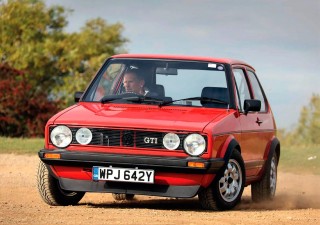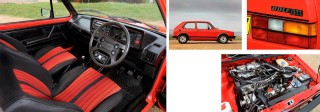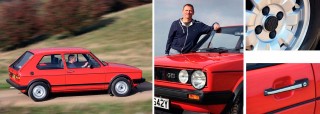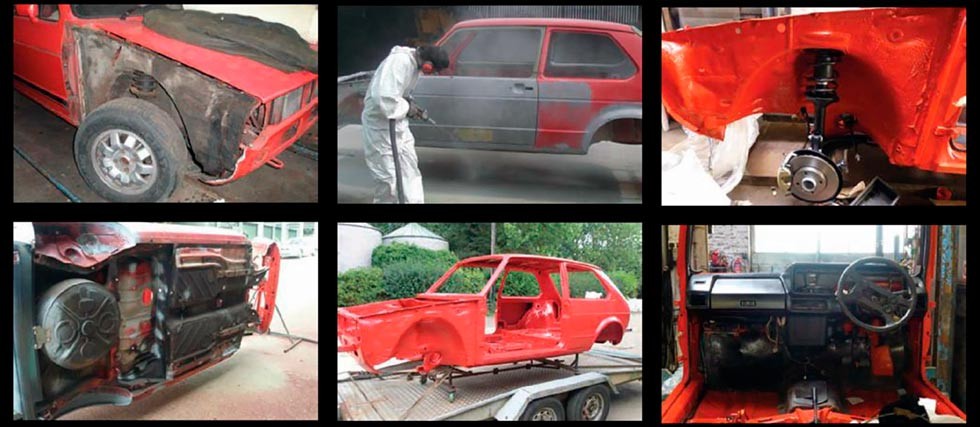EPIC READER RESTO!
Mk1 Golf GTI restored Epic eight-year project. Hot-hatch legend reborn Full story behind the rebuild of Dave Hirons’ Volkswagen Golf GTI Mk1.
style=”flat” size=”4″]Factory-fresh restorations are all well and good when vast sums of money are thrown in the direction of a marque specialist, but truly impressive is the owner who juggles a multitude of things – including work and family commitments – to achieve the same result.
Walking around Dave Hirons’ spotless 1982 Volkswagen Golf GTi MkI, there’s little, if anything, to cause the slightest murmur from even the strictest concours judge. It’s all there, right down to the barcode sticker on the inside of the door with the chassis number on it.
“They’re the little details that nobody notices,” says Hirons, “but they really make the car.” But wait – what about that gearlever? “Genuine Kamei accessory.”
The original plan had been for a daily driver, but then Hirons’ meticulous nature kicked in: “Even when I built race cars in my spare time – which I did between 1986 and 2011 for series including Mini Miglias, VW Cup and Masters Classic – I’d have to do it to a certain standard. “With the GTI, I restored it at my lifelong friend Dave Kirkham’s workshop. His wife Joy used to laugh at me. ‘Why are you painting that?’ she’d ask. ‘Nobody will even see it.’ Maybe not, but I would have known.”

Having hung up his racing tools, Hirons decided to restore a road car and toyed with the idea of a Mercedes R129 SL, before settling on a Mk1 Golf GTI: “The SL might have been a better fit for my current role in passenger technical support at Mercedes-Benz, though…”
Not that there was anything amusing about the body restoration. Hirons bought an MoT’d Mars Red example even though it had a nonstandard factory sunroof, and set to work: “I started by replacing the front panel, then the rotten inner rear wing. As I went round, I found more and more rot. On one of the rear wings I experienced the bit you dread when you’re cutting – a big white cloud of filler exploded.”
He estimates that it took 12 months, working evenings, weekends and holidays, to complete the bodyshell: “When you’ve sat in an office all day, taking an angle grinder to metal, or a wire wheel to underseal, gives you something completely different.” Likening it to having two marriages, Hirons says it was always family first and then car: “It allowed me to de-stress, and indirectly that was good for everyone.”
With the body complete, there was just one Hirons has had plenty of use out of the car since its completion, even if his original plan of building a daily driver was dropped. Below: late 1588cc engine – the 1780cc variant was introduced in 1982 problem – he wasn’t happy. Not with his workmanship, but the fact that he’d replaced so much metal: “I began looking for another car and saw a stripped-down, ex-track-day GTI shell on eBay, bid £400, forgot about it and won. It was the same year, colour and type, but had original sills and arches. I thought, ‘What do I do now?’”
The answer was to sell the repaired shell and start again: “I was completely open and explained that I had a better, more original body.”
So began yet more metalwork, although this time it was less involved: “The chassis rails had been dented from people using them to jack up the car. You can get repair sections but it’s quite intrusive and they never look the same.”
So Hirons thought outside the box – or rather, inside it. He removed the sound-deadening panels, sliced open the floor for access and straightened the rails from within, before welding everything back together.
With the body away being painted, Hirons set to work on the engine. Knight Engineering Services rebored the block and reground the crankshaft, while he sourced new shells, oil pump, pistons, machined valves and guides. “It was a bit of a journey,” he remembers. “The pistons were a challenge to find, and the oil pump – I didn’t realise how different Mk1 units are, but VW Heritage helped me out. If you’re doing something like this and parts are available, then you’ve got to buy them while they’re there.”
Hirons has had plenty of use out of the car since its completion, even if his original plan of building a daily driver was dropped. Below: late 1588cc engine – the 1780cc variant was introduced in 1982. Clockwise: pristine cabin – sourcing a good set of seats was a challenge; Giorgetto Giugiaro’s compact, crisp profile; original Golf was the king of the early hot hatches.

The block was painted with new core plugs fitted – the aluminium aqua-blasted to keep it as close to original as possible – before Hirons rebuilt the engine. His example is a crossover between the Series 1 and 2, so it has a 1588cc powerplant, S1 fusebox – correct for an early S2 – and, most importantly, a five-speed gearbox. “Everyone thinks that the gearboxes are the same,” says Hirons, “but they’re not. There are three versions: short shaft, long shaft and 16-valve long shaft. Mine was the short-shaft, with closer-ratio gears, but one of the bearings on the end has a different internal diameter to the other ’boxes and you just can’t get them.”
Hirons came up with a solution but didn’t have a lathe to do it. Luckily, his uncle is an engineer and fabricated the bush he’d designed to take up the play: “It solved the problem and I’m now able to replace it in future, if necessary.”
Then came a game-changer – the return of the bodyshell. As soon as he saw it in painted form the idea of a daily driver soon subsided: “It was just too good.” Couple that with the buzz of finding hard-to-get parts, and suddenly Hirons had the concours bug: “I thrive on challenges, and sourcing things was exactly that.”
If he wanted the car to drive like new, even the smallest component had to be replaced or refurbished. Fresh Sachs suspension came from VW, including new bushes, balljoints, suspension arms, dampers, springs and mounts, struts and strut inserts: “If I could, I got genuine parts, sourcing New Old Stock where available.”
The wiring loom had a little damage on it, but the grommets were good – people often cut them to run accessory wires through the bulkhead. With some repairs, as well as a new fusebox and connectors, it was brought up to standard. With body and running gear finally back together, Hirons set to work finishing things off: “It took about six months, paying attention to the smallest detail. Sourcing the right parts was critical to making it look right.”
He bought a good second-hand set of fuel pipes and had them re-passivated, while those specifically around the accumulator came from the original supplier, now based in Poland.
Richard Masters at Crazy Quiffs, meanwhile, sourced correct new steel brake pipes. “The originals had a green plastic coating on them and I wanted the same,” says Hirons, “but they were absolute horrors to bend and get all the right shape. I had to do it by hand, using thumbs and forefingers. It was incredibly time-consuming, and I had to be in the right frame of mind – if I wasn’t, I just walked away.”
The original dashboard had been drilled and cut multiple times, but luckily the brother of a friend in the Mk1 Golf Owners’ Club was selling a GLX, and Hirons was able to enact a swap. The interior proved to be a headache, though: “The seats are notoriously bad for fading, particularly in the back. You could still buy the grey and black material, but not the red and orange.” He bought a number of seats, then went through a process of mix and match. “It was roughly four complete sets that I had to use,” he remembers, “and I had to travel all around the UK to collect them.”
Newton Commercial supplied a new headlining, and Hirons retrimmed a blue parcel shelf in black to replace the broken old one. An original windscreen came from VW Heritage for the princely sum of £100, but other parts were “crazy prices”. Fresh badges came from the same source, an aerial from the USA, and the original wheels were powder-coated before being shod with Uniroyal tyres with a retro tread pattern. The final job was to fit the plastic wheelarch trims: “I wanted to put the rears on. The ramp didn’t have a wheel free, so I put axle stands under the jacking points and whipped off the wheels, but it fell off the stands. I thought it was going off the ramp but luckily, as the back of the car swung round, the central hub of the brake drum caught the lip on the edge of the ramp and stopped it. There was no damage at all.”
Clockwise, from main: the Golf drives beautifully, as you’d expect after such an exacting rebuild; slender doorhandles; original alloys were refurbished; proud owner Hirons.

After this lucky escape, and eight years after Hirons started, the GTI was finally finished: “I completed my apprenticeship many years ago with Dave Kirkham, so I knew him pretty well. Even so, when I started doing the project in his workshop, I said it would take only two years. “Everyone I’ve been in contact with has just wanted to help. When you mention you’re restoring a Mk1 Golf GTI, their eyes light up. That’s been refreshing after so long in the retail side of the motor trade, where people don’t always have that passion and interest.”
Response to the VW has been fantastic, with it securing Best Standard Car at Edition 38 and runner-up at GTI International, then placing in the top five at the 2016 Mk1 Owners’ Club event and the top 20 at the GTI Festival. To top it all, it appeared on the Golf Mk1 Owners’ Club stand at the Lancaster Insurance Classic Motor Show. “It’s nice to have the recognition for what we’ve managed to achieve, and for all the blood, sweat and tears,” says Hirons. “In standard form, they’re few and far between now.”
Everything about the car is a timewarp, transporting you back to the early 1980s, and the best bit is that it drives as well as it looks. You can see why, in their day, the accurate controls and level of communication, combined with sheer practicality, set the benchmark in terms of all-round ability. The sound, feel, vibration and noise connect you to the tarmac like nothing today. “I even love the rattles and squeaks that come with it,” explains Hirons. “Finding them simply adds another challenge.”
Fettling is an ongoing process. Coming back from GTI International, the gearbox started making a funny noise: “I changed down then up, and there was a ‘tick, tick, tick’. I knew it wasn’t right, and when I took it out and stripped it, a part had snapped off the synchro hub and gone through the gearbox, damaging the crownwheel and pinion. It must have been cracked when I fitted it; that’s 35-year-old parts for you. Richard at Crazy Quiffs helped me to source an incredibly hard-to-find replacement.”
The rest of the Hirons clan loves the car, and they all go to shows together with a picnic in the back: “Club events are a real family day out. My wife didn’t understand why I needed to go to that level of detail; or why I spent so much money – £4000 on the paintwork alone. Now, though, she appreciates all the time I put into it.”
That’s because almost anybody can restore a car, but to get it back to near-perfect factory specification takes time, patience, tenacity, money and ingenuity. All of those values are perfectly reflected here.
Work in progress

From top: original shell starts to come apart; it was placed on chassis tilter for ease of access; taking it back to bare metal; second shell in paint; new suspension and brakes; replacement dash.
“MY WIFE DIDN’T REALLY UNDERSTAND WHY I NEEDED TO GO INTO THAT LEVEL OF DETAIL”





